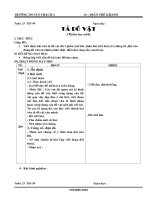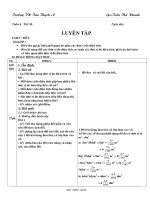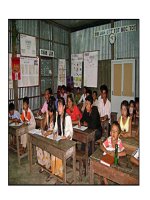- Trang chủ >>
- Mầm non - Tiểu học >>
- Lớp 5
5 11 the home front
Bạn đang xem bản rút gọn của tài liệu. Xem và tải ngay bản đầy đủ của tài liệu tại đây (3.58 MB, 10 trang )
Fascinating Facts
•
During World War II, families saved meat fats from
cooking and took them to butcher shops. The fat was
used to make glycerin, which was important in making
explosives for the Allies.
•
American factories produced more than 250,000 aircraft
during World War II.
•
Alarm clocks were in short supply during the war, until
factory workers kept showing up late. After that, “victory
models” were manufactured that used very little metal.
Genre
Nonfiction
Comprehension Skill
Draw Conclusions
Text Features
• Sidebars
• Captions
• Table of
Contents
Scott Foresman Social Studies
ISBN 0-328-14913-6
ì<(sk$m)=bejbdb< +^-Ä-U-Ä-U
BY
TAMMY ZAMBO
Millions of Americans served in the military in World
War II, and their service helped the Allies win the
war. Just as important, however, were the efforts of
ordinary people in the United States on the home
front. In this book you will read about what life was
like for many people on the home front and how the
country changed during the war.
Write to It!
What changes on the home front do you
think were the most helpful to the war effort?
Which changes do you think were not helpful?
Write two or three paragraphs explaining
your answers.
Vocabulary
blackout
Write your ideas on a separate sheet of paper.
internment
rationing
Table of Contents
The Home Front .................................................page
2
Civilian Defense for All ......................................page
4
The Conversion of Business ..............................page
5
Boomtowns ........................................................page
6
Opportunities for Women..................................page
8
The Internment Camps ......................................page 10
Daily Life on the Home Front ...........................page 12
Children on the Home Front .............................page 14
Photographs
What Mattered Most ..........................................page 15
BY
TAMMY ZAMBO
Every effort has been made to secure permission and provide appropriate credit for photographic material. The publisher deeply
regrets any omission and pledges to correct errors called to its attention in subsequent editions.
Unless otherwise acknowledged, all photographs are the property of Scott Foresman, a division of Pearson Education.
Photo locators denoted as follows: Top (T), Center (C), Bottom (B), Left (L), Right (R) Background (Bkgd)
ISBN: 0-328-14913-6
Copyright © Pearson Education, Inc.
All Rights Reserved. Printed in the United States of America. This publication is protected
by Copyright, and permission should be obtained from the publisher prior to any prohibited
reproduction, storage in a retrieval system, or transmission in any form by any means,
electronic, mechanical, photocopying, recording, or likewise. For information regarding
permission(s), write to: Permissions Department, Scott Foresman, 1900 East Lake Avenue,
Glenview, Illinois 60025.
1 2 3 4 5 6 7 8 9 10 V0G1 14 13 12 11 10 09 08 07 06 05
Opener: ©Corbis
Editorial Offices: Glenview, Illinois • Parsippany, New Jersey • New York, New York
2 ©United States Air Force
5 ©The Granger Collection,
NY Offices: Needham, Massachusetts • Duluth, Georgia • Glenview, Illinois
Sales
7 ©Getty Images
Coppell,
Texas • Sacramento, California • Mesa, Arizona
8 ©Corbis
9 ©Getty Images
10 ©Corbis
11 ©Seattle Post-Intelligencer Collection; Historical Society of Seattle & King County dba Museum of History/Corbis
13 ©Corbis
14 ©Getty Images
The Home Front
World War II was an armed conflict between the Allies and
the Axis powers. In the United States, people focused on the
progress of the war and on the troops who were fighting it.
However, the United States could not have contributed to ending
the war so successfully without the government, businesses,
and millions of everyday people on the home front. People of all
ages and from all parts of the country pulled together and made
sacrifices for the war effort.
Women in the Military
After the bombing of Pearl Harbor, Hawaii, on December
7, 1941, the military needed to train millions of people for
battle overseas. Many Americans eagerly volunteered. Others
were required to serve because of the draft. All of these people,
however, were men. Women were not allowed to serve on the
battlefield and were not drafted.
Women pilots in the Women
Airforce Service Pilots
(WASP) flew many types
of planes during the war.
The military had a problem, though. With a large number of
men serving overseas, many important military positions on the
home front were vacant. The military created units in which
women could sign up to fill the empty positions.
In large numbers, women across the country signed up.
They were proud to serve in the military, and were also
determined to show everyone that they could do the jobs just as
well as men.
Every branch of the military set up at least one organization
specifically for women. Women in the army and navy nurse
corps traveled all over the world to nurse wounded American
soldiers and sailors. Women pilots who joined the Women
Airforce Service Pilots (WASP) flew all types of planes, including
fighters and bombers. One of their jobs was to deliver planes
from factories to American troops who were waiting to take the
planes overseas. Women in the Coast Guard Women’s Reserve
(known as SPARS) prepared parachutes and coded and decoded
messages sent to ships. By the end of the war, more than
244,000 women had served in the military.
The Women in Military Service for America Memorial
The Women in Military Service for America Memorial in
Arlington, Virginia, honors the nearly 2 million women who served
in the military in World War II, in other United States wars, and
in times of peace. Located at the entrance to Arlington National
Cemetery, the memorial was dedicated and opened to the public
in 1997. The memorial is really a small museum. It contains
many artifacts, letters, and photographs pertaining to the role of
women in the United States military.
2
3
Civilian Defense for All
Not everyone could serve in the military, but there were
plenty of other necessary roles to fill. A new agency called the
Office of Civilian Defense (OCD) encouraged citizens to give
“an hour a day for the U.S.A.” Towns and cities needed to be
prepared in case they were attacked by an enemy, especially
from the air. Some people volunteered to be wardens, organizing
a block or a neighborhood to plan for air raids, or enemy
aircraft attacks. They conducted alarm drills and made sure
that people observed blackouts. A blackout is when lights are
turned off to hide targets from the enemy during an air raid at
night. Blackouts were also ordered along the East Coast so that
American ships sailing close to shore would not be seen against
city lights. This practice would keep ships more safe from
attack by German submarines.
Many citizens who could fly planes volunteered for the
Civil Air Patrol (CAP). CAP pilots flew small planes as they
transported military staff, blood supplies, and mail from one
place to another. They also flew over factories in mock bombing
raids. They would drop sacks filled with flour to show that some
landmarks needed to be disguised.
4
Aircraft and other war materials were built on assembly lines, just
as cars had been during peacetime.
The Conversion of Business
All across the country, factories made adjustments to
manufacture equipment, weapons, and other goods for the war.
Automobile factories stopped making cars and started making
trucks, tanks, and other military vehicles, as well as airplanes,
engines, and many kinds of weapons. Aircraft parts were being
made by a washing machine company. A producer of typewriters
now manufactured rifles.
These changes to war production created millions of new
jobs. These jobs paid better wages than many people could
make in their hometowns, so over 15 million people moved.
The United States had never before experienced so many people
moving at once. Therefore, many cities experienced a severe
shortage of housing.
5
The Boom is Nationwide
Boomtowns
The population boomed in towns where shipyards, aircraft
factories, and military bases were located. For this reason, they
were called boomtowns. People moved to boomtowns so quickly
that housing was scarce. Homeowners took in boarders, which
meant that they rented spare rooms in their homes to strangers.
Trailer and tent camps sprang up around many cities when
space in houses ran out. Some people even slept in parked cars.
The community of Willow Run, Michigan, experienced rapid
population growth when a new aircraft factory operated there.
Eventually this factory would employ more than forty thousand
people. To house its giant assembly line, the factory at Willow
Run was one mile long! Another aircraft factory at Fort Worth,
Texas, was so large that supervisors rode bicycles inside the
building in order to visit different parts of the factory.
Even though millions of people endured hardships like
these to find work during the war, most were thrilled with the
result. Workers were paid well, and many people experienced
opportunities they had never dreamed of. The Great Depression
had finally ended.
Shipyards along the east and west coasts of the United States
were expanded during the war, and new shipyards were built.
However, there was still a great need for more ships. Many ships
that were used by the United States Navy during World War II
were actually built on the Great Lakes in the midwestern United
States! After they were completed, these ships were placed on
large barges and floated down the Mississippi River to the ocean
at New Orleans, Louisiana.
Many shipyards and factories operated twenty-four hours per
day during the war. This meant that there were different shifts of
workers who were busy each day. With so many workers crowding
into the available housing in boomtowns, workers often had to
take turns sleeping because there were not enough beds to
go around. Often, a worker who had just finished working the
daytime shift at a factory or a shipyard would go to sleep in a bed
that had just been vacated by another worker who was leaving to
work the evening shift.
Overcrowded boardinghouses were
common in boomtowns. Here, factory
workers are eating a meal.
6
7
Opportunities for Women
Those who found the greatest employment opportunities were
women. Before the war, it was considered ideal for women to
work in the home. However, millions of men had left their jobs
to serve overseas, and millions of new jobs had been created.
Women’s skills were desperately needed for war work.
The government encouraged women to join the workforce,
and more than six million of them did. Many of them were
inspired by billboards and posters featuring images such as
Rosie the Riveter. They were eager to contribute to the war
effort, and they tackled their new jobs with enthusiasm.
Still, many men did not believe women could perform
factory jobs as well as men. They sometimes teased and joked
about the women workers.
Often their comments only
encouraged women to show
the men—and themselves—
that they were fully able to
do their jobs.
Besides the women who worked for wages, millions of women
worked in important programs as volunteers. In the Red Cross,
they operated snack bars called canteens, served as nurses’
aides, and drove ambulances. They also worked in civilian
defense programs and at USO (United Service Organizations)
centers. These centers provided entertainment for soldiers.
By 1944, 36 percent of the paid workforce was made up of
women. Without their contributions, the Allies could not have
won the war. Yet women were paid 40 percent less than men for
working in the same jobs. In addition, most women lost their
jobs to men when the men came home from war. Many women
returned to homemaking, even though they preferred to keep
working outside the home.
Many women joined the workforce, as in this assembly line.
This poster of Rosie the Riveter, and
others like it, urged women to go to
work for the war effort.
8
9
Japanese American families wait for a bus to take them to an
internment camp. The children are wearing identification tags in
case they become separated from their parents.
The Internment Camps
Americans pulled together to win the war, and their
determination boosted their spirits. For many people, however,
pulling together also meant discriminating against some of their
fellow Americans. After Japan bombed the United States naval
base at Pearl Harbor, many people felt that Japanese Americans
could not be trusted. They were afraid that some Japanese
Americans might give important information to the Japanese
government or damage property in the United States. The
government also had the same fears about Japanese Americans.
Immigrants from Japan could not yet become United States
citizens, but they were loyal to America anyway. In addition,
their children who were born in the United States automatically
became citizens. Nevertheless, in February 1942, President
Franklin Roosevelt signed an order which allowed United States
Army commanders to order the removal of Japanese Americans
from the West Coast of the United States.
10
Shortly thereafter, some 120,000 Japanese Americans had to
leave or sell their homes and businesses, or trust others to keep
them safe until they could return. The Japanese Americans were
taken to internment camps built especially to house them. Eight
of the ten camps were located in isolated and barren areas in six
western states. Two more were located in Arkansas. Surrounded
by barbed wire and guarded by soldiers, the Japanese Americans
were forced to live in the cramped, dusty camps. Once there,
they tried to reestablish a normal daily life.
Despite the harsh way they were treated, Japanese Americans
were very patriotic. Many Japanese American men served in the
United States Army during the war. Japanese Americans were
forced to stay in the camps for as long as three years. Gradually,
however, the government released them. Finally, in early 1945,
the camps began to close.
Japanese Americans lived in assembly centers while the
relocation centers (internment camps) were being built.
11
Daily Life on the Home Front
Every day Americans were reminded of the war. The most
constant reminders were shortages and rationing. Many
ordinary goods were scarce. Metal was needed for building
ships, airplanes, vehicles, and weapons, so items like bicycles
were not produced. Automobile factories were used for war
production, so new cars for private citizens were not built.
Supplies of shoes were limited because the leather was needed
for soldiers’ boots.
Common foods such as sugar, coffee, butter, cheese, and meat
were rationed so that everyone got some but no one got too
much. Every family was given ration books with stamps that
represented points used to buy certain products.
To help feed their families, many people all over the country
grew their own vegetables in victory gardens. These gardens
became so popular that they produced more than one-third
of the vegetables eaten in the United States during the war.
Households gave away any extra vegetables to the needy, or
canned them for later use.
Gasoline was also rationed, and Americans adopted new
habits to get from place to place. Walking and carpooling
became common. For longer journeys, people took trains.
Frequently, though, they did not go anywhere at all. Families
stayed at home. Many adults were working extra hours in
factories and did not have much time to travel anyway.
People also wrote letters often, especially if a family member
was in the military. Families hung a banner in the window,
with blue stars to show how many members of the family were
serving in the military. If one of them died, the blue star would
be replaced with a gold one.
The banner shows how
many family members are
serving in the military.
12
13
In their spare time, children listened to radio programs such
as The Lone Ranger and The Shadow. They read comic books
featuring Captain Marvel, Batman, and Superman. Newspaper
comics such as Little Orphan Annie were popular too. Going
to the movies was a regular weekend event for many families.
For about ten cents, each person could watch a double feature,
or two movies. Between the two movies, newsreels, or news
reports, updated them with images of the war.
Many teenagers worked in factories and on farms. Many
states eased child-labor laws during the war so that teenagers
could work. Nearly three million girls and boys were working
by 1943.
In their spare time, teenagers enjoyed listening to swing
music played by “big bands” led by Glen Miller, Benny
Goodman, Duke Ellington, and others. A young singer, Frank
Sinatra, was hugely popular. In 1944, thousands of teenage girls
nearly rioted as they tried to get near him.
Children responded gladly when President Roosevelt asked the
nation to recycle scrap rubber and metal.
Children on the Home Front
Children played important roles in the war effort. Many of
them joined civilian defense teams. One boy in New York, for
example, was an air raid messenger. He passed on messages
between commanders at air raid posts during alarm drills.
Children organized scrap drives, collecting paper, metal cans,
and rubber tires from people in their neighborhood. They also
contributed their own metal toys and foil that they had saved
from packages of gum. These items were recycled to make warrelated goods.
14
What Mattered Most
Millions of Americans worked hard and made many
sacrifices on the home front in World War II. Daily life for
nearly everyone changed completely. However, even though life
was not easy, people found comfort in the thought that they
were helping men and women who were serving in the military.
They thought their efforts were helping to win the war, which
was what mattered most.
15
Millions of Americans served in the military in World
War II, and their service helped the Allies win the
war. Just as important, however, were the efforts of
ordinary people in the United States on the home
front. In this book you will read about what life was
like for many people on the home front and how the
Glossary
country
war.
blackoutchanged
turningduring
out of the
lights
to hide targets from
Write to It!
What changes on the home front do you
think were the most helpful to the war effort?
Which changes do you think were not helpful?
Write two or three paragraphs explaining
your answers.
an enemy during an air raid at night and from
submarines offshore
Vocabulary
internment holding and limiting the movement of
blackout
people during wartime
internment
rationing government limiting the amount of food
rationing
and other goods each
person can buy
Write your ideas on a separate sheet of paper.
Table of Contents
The Home Front .................................................page
2
Civilian Defense for All ......................................page
4
The Conversion of Business ..............................page
5
Boomtowns ........................................................page
6
Opportunities for Women..................................page
8
The Internment Camps ......................................page 10
Daily Life on the Home Front ...........................page 12
Children on the Home Front .............................page 14
Photographs
What Mattered Most ..........................................page 15
Every effort has been made to secure permission and provide appropriate credit for photographic material. The publisher deeply
regrets any omission and pledges to correct errors called to its attention in subsequent editions.
Unless otherwise acknowledged, all photographs are the property of Scott Foresman, a division of Pearson Education.
Photo locators denoted as follows: Top (T), Center (C), Bottom (B), Left (L), Right (R) Background (Bkgd)
ISBN: 0-328-14913-6
Copyright © Pearson Education, Inc.
All Rights Reserved. Printed in the United States of America. This publication is protected
by Copyright, and permission should be obtained from the publisher prior to any prohibited
reproduction, storage in a retrieval system, or transmission in any form by any means,
electronic, mechanical, photocopying, recording, or likewise. For information regarding
permission(s), write to: Permissions Department, Scott Foresman, 1900 East Lake Avenue,
Glenview, Illinois 60025.
1 2 3 4 5 6 7 8 9 10 V0G1 14 13 12 11 10 09 08 07 06 05
16
Opener: ©Corbis
2 ©United States Air Force
5 ©The Granger Collection, NY
7 ©Getty Images
8 ©Corbis
9 ©Getty Images
10 ©Corbis
11 ©Seattle Post-Intelligencer Collection; Historical Society of Seattle & King County dba Museum of History/Corbis
13 ©Corbis
14 ©Getty Images









